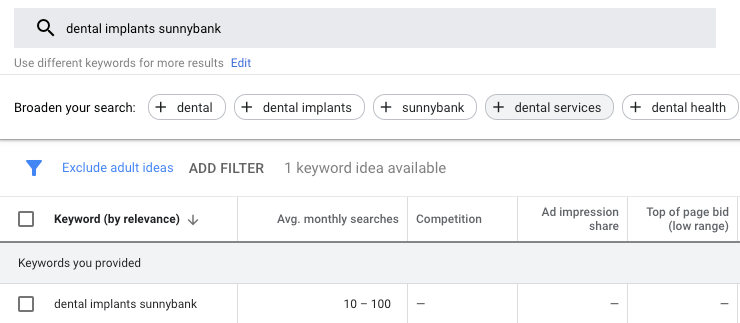For many dentists, their service pages aren’t getting the visibility they could be getting. They’re buried in Google’s search results – and, in turn, they’re missing out on a lot of new patients.
Just because your homepage is ranking well doesn’t mean your pages on implants and cosmetic dentistry are doing the same. An effective search engine optimisation (SEO) strategy is required to get more eyes on these pages and more new patients for your most profitable services.
In this article, we’ll focus on what you can expect when ranking your dental service pages and what you can do to overcome the many potential SEO obstacles in your path.

Why Ranking Your Dental Service Pages is Important
From a ranking perspective, it’s important to understand why your service pages are so important. There’s a finite number of patients who live or work within commuting distance of your practice. Every dentist is competing for this same pool of patients.
In essence, Google is crowded – but vital - real estate.
Keep in mind, the goal isn’t to attract any and every visitor to your website. SEO is about attracting qualified website visitors who are actively seeking dental care in your area.
The key is to rank for relevant, geographically-based keywords. Let’s use your homepage as an example. If you’re a dentist practicing in Sunnybank, Queensland, you’d want to rank for a keyword like, “dentist sunnybank.”
This shows what the searcher is looking for (a dentist) and where they are looking for it (Sunnybank). But not every prospective dental patient is searching that particular keyword. Some may be searching for a specific dental procedure.
Which is where your service pages come in. If you want to schedule more implant appointments, you’ll want your implants page to rank for service-specific keywords like, “dental implants sunnybank” or “implant specialist sunnybank.”
Remember, there is a finite number of patients in your area. Get in front of as many of them as possible.

Research Your Competition
Every jurisdiction is different. The size of your new patient drawing area, the competition in your jurisdiction, etc. If you’re going to compete with the potentially dozens of other dentists in your area, you have to know what they’re up to.
Start with a Google search. Get in the mind of a prospective patient. What keywords are they searching when they’re seeking a particular dental service? If it’s teeth whitening, it might be, “teeth whitening [your jurisdiction].”
Perform your search and then evaluate the top five ranking websites. These are the sites you want to focus on. Ideally, you want to reach the top three.
Use the criteria below to see how your service pages currently stack up and what you can do to rise to the top.
Know Your Authority
Among the most important factors in ranking (and most challenging to exceed at) is domain authority and page authority. In short, here’s how to distinguish between the two:
- Domain authority: Measures the strength of your entire domain (i.e. happysmiles.com)
- Page authority: Measures the strength of a single page (i.e. happysmiles.com/implants)
Ranking authority depends on, literally, hundreds of factors – the age of your domain, how many websites link to you, the quality of backlinks, and on and on. It helps Google determine whether they can trust your website more or less than other sites.
Say you’re trying to rank your implants page against a website that is five years older and has double the amount of backlinks. Right off the bat, you’re at a disadvantage.
However, there’s hope with the right dental SEO, or PPC (which we’ll cover later on), strategy.
Build a Dental SEO Plan
SEO is the key to boosting your Google rankings. It can be broken down into two categories: On-page SEO and off-page SEO.
- On-page SEO includes many technical aspects of your website and the activities you pursue to optimize on your website. This could include URL structure, page speed, internal linking, keyword research, etc.
- Off-page SEO includes activities to boost your authority off your website. This could include reaching out to other businesses for backlinks and promoting your content on social media.
For ranking a service page, on-page SEO is critical. Let’s go back to the example of ranking a dental implants page. Here are several things you can do to ensure that page (and your website as a whole) is set up for success:
- Ensure that your website loads fast, because Google factors in speed when ranking any page on your site.
- Incorporate the right keywords throughout your page. For example, the heading of your implants page might be something like, “Dental Implants in [Jurisdiction].” Then throughout the content inject phrases like, “Dental implants to strengthen your smile.”
- Link internally from other pages on your site. For example, you’ll want to link from your homepage (considering it typically holds the most page authority) as well as other relevant pages throughout your site (other service pages, relevant blog posts, etc.).
- Ensure that your title tag is relevant and includes SEO-friendly keywords. For example, “Dental Implants [Jurisdiction] | Happy Smiles”

Focus on Content
Quality content is always important. Sometimes the quality of content (and quantity) on your service pages can overcome difficult or unavoidable SEO challenges like domain age and backlink profile.
Occasionally there may be an outlier where your competitors in the top few spots are not dental service pages. For example, the website ranking second might be a directory listing and the website ranking third might be an educational blog post about dental crowns.
You could beat these sites by incorporating relevant, locally-based keywords (to beat the blog post) and longer, high quality content (to beat the directory listing).
Also keep in mind, you can’t expect to rank for a particular service if it doesn’t have its own page. We see this a lot when onboarding new dental clients. They have one page that outlines every service they offer.
This doesn’t work. Every service must have its own page.

If All Else Fails…
As you can see, there’s a lot to consider when ranking your dental service pages. Sometimes, however, it’s inevitable: The competition is too fierce and you can’t rely on SEO alone. Or, you have a competitor that is 100% dedicated to the service you’re attempting to target (i.e. you are a general dentist with one braces page and you’re competing against a multi-doctor orthodontic practice).
Rarely do we say something is impossible. This might be.
Entering… Google Ads. Google’s paid advertising service gives you the best search engine real estate. By setting up a Google Ads campaign, you can “rank” at the top of the first page of Google for any search term.
There are countless benefits of advertising your service pages on Google. One, it gives you instant visibility to your most profitable services. You can start getting new patients in, literally, a matter of days.
Another benefit to advertising your service pages is you’ll likely have a lower cost per click. Why? There’s less competition for those types of keywords. Every dentist running a Google Ads campaign is targeting search terms like, “dentist [jurisdiction].” Not everyone is targeting terms like, “dental implants [jurisdiction],” “cosmetic dentistry [jurisdiction],” etc.
It’s a simple formula: Less competition = lower cost per click.
Plus, Google Ads gives you a measurable return on investment. From form submissions to tracking incoming calls, you know precisely how many new patient leads come from your ads.
For most dentists, Google Ads is a no-brainer. It’s a predictable marketing channel that will draw a steady flow of new patients month after month.


